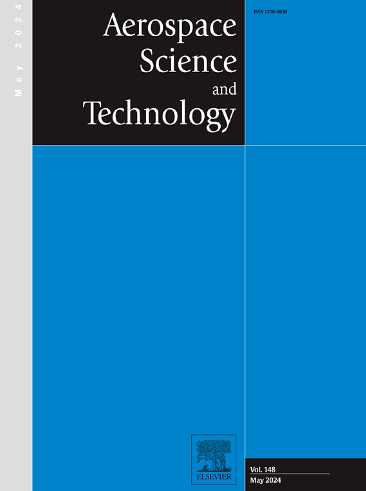Numerical investigation of the velocity-coupled response of propellant burning rate in a solid rocket motor
IF 5
1区 工程技术
Q1 ENGINEERING, AEROSPACE
引用次数: 0
Abstract
Serving as one of the primary gain sources in solid rocket motors, the burning rate response crucially determines the properties of combustion instability, which, however, still remains largely unexplored, particularly velocity-coupled burning rate response. This numerical study integrates a microscopic sandwich flame model with a macroscopic rocket internal flow field, considering the gas-solid coupling process, to investigate the velocity-coupled burning rate response of solid propellants subjected to transverse acoustic forcing in a solid rocket motor. The oscillatory flow field and flame dynamics are first analyzed, examining the variation pattern of velocity fluctuation amplitude with frequency near the burning surface and the disturbance source characteristics of the flame. Subsequently, both the pressure-coupled response function () and the velocity-coupled response function () are derived to investigate the frequency response of the burning rate. peaks in the second acoustic mode, potentially clarifying why the second harmonic frequently exhibits the highest amplitude in the combustion instability of real solid rocket motors. The phase relationship between velocity and flame heat release fluctuations in space is analyzed, explaining the response mechanism of burning rate to the velocity oscillation frequency. The impact of oxidizer particle sizes on is also explored. Smaller oxidizer particle sizes lead to a shift in the peak of towards higher harmonics, emphasizing the crucial role of reaction diffusion distance in velocity-coupled responses. Our work introduces a novel approach to studying propellant burning responses, particularly addressing the gap in numerical studies of velocity-coupled responses, potentially leading to enhanced understanding and control of combustion instability.
求助全文
约1分钟内获得全文
求助全文
来源期刊

Aerospace Science and Technology
工程技术-工程:宇航
CiteScore
10.30
自引率
28.60%
发文量
654
审稿时长
54 days
期刊介绍:
Aerospace Science and Technology publishes articles of outstanding scientific quality. Each article is reviewed by two referees. The journal welcomes papers from a wide range of countries. This journal publishes original papers, review articles and short communications related to all fields of aerospace research, fundamental and applied, potential applications of which are clearly related to:
• The design and the manufacture of aircraft, helicopters, missiles, launchers and satellites
• The control of their environment
• The study of various systems they are involved in, as supports or as targets.
Authors are invited to submit papers on new advances in the following topics to aerospace applications:
• Fluid dynamics
• Energetics and propulsion
• Materials and structures
• Flight mechanics
• Navigation, guidance and control
• Acoustics
• Optics
• Electromagnetism and radar
• Signal and image processing
• Information processing
• Data fusion
• Decision aid
• Human behaviour
• Robotics and intelligent systems
• Complex system engineering.
Etc.
 求助内容:
求助内容: 应助结果提醒方式:
应助结果提醒方式:


